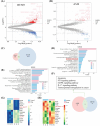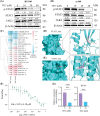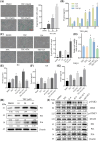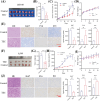Metochalcone induces senescence-associated secretory phenotype via JAK2/STAT3 pathway in breast cancer
- PMID: 38686052
- PMCID: PMC11055985
- DOI: 10.32604/or.2023.044775
Metochalcone induces senescence-associated secretory phenotype via JAK2/STAT3 pathway in breast cancer
Abstract
Breast and lung cancers are the leading causes of mortality and most frequently diagnosed cancers in women and men, respectively, worldwide. Although the antitumor activity of chalcones has been extensively studied, the molecular mechanisms of isoliquiritigenin analog 2', 4', 4-trihydroxychalcone (metochalcone; TEC) against carcinomas remain less well understood. In this study, we found that TEC inhibited cell proliferation of breast cancer BT549 cells and lung cancer A549 cells in a concentration-dependent manner. TEC induced cell cycle arrest in the S-phase, cell migration inhibition in vitro, and reduced tumor growth in vivo. Moreover, transcriptomic analysis revealed that TEC modulated the activity of the JAK2/STAT3 and P53 pathways. TEC triggered the senescence-associated secretory phenotype (SASP) by repressing the JAK2/STAT3 axis. The mechanism of metochalcone against breast cancer depended on the induction of SASP via deactivation of the JAK2/STAT3 pathway, highlighting the potential of chalcone in senescence-inducing therapy against carcinomas.
Keywords: Breast cancer; JAK2/STAT3; Lung cancer; Metochalcone; SASP.
© 2024 Zhou et al.
Conflict of interest statement
The authors declared no conflicts of interest.
Figures






Similar articles
-
Pterostilbene suppresses gastric cancer proliferation and metastasis by inhibiting oncogenic JAK2/STAT3 signaling: In vitro and in vivo therapeutic intervention.Phytomedicine. 2024 Jun;128:155316. doi: 10.1016/j.phymed.2023.155316. Epub 2023 Dec 25. Phytomedicine. 2024. PMID: 38518635
-
Activation of JAK2/STAT3 signaling by osteopontin promotes tumor growth in human breast cancer cells.Carcinogenesis. 2010 Feb;31(2):192-200. doi: 10.1093/carcin/bgp289. Epub 2009 Nov 19. Carcinogenesis. 2010. PMID: 19926637
-
P16 promotes the growth and mobility potential of breast cancer both in vitro and in vivo: the key role of the activation of IL-6/JAK2/STAT3 signaling.Mol Cell Biochem. 2018 Sep;446(1-2):137-148. doi: 10.1007/s11010-018-3281-4. Epub 2018 Jan 31. Mol Cell Biochem. 2018. PMID: 29388151
-
Induction of metastatic potential by TrkB via activation of IL6/JAK2/STAT3 and PI3K/AKT signaling in breast cancer.Oncotarget. 2015 Nov 24;6(37):40158-71. doi: 10.18632/oncotarget.5522. Oncotarget. 2015. PMID: 26515594 Free PMC article.
-
An insight into the therapeutic effects of isoliquiritigenin in breast cancer.Naunyn Schmiedebergs Arch Pharmacol. 2024 Dec;397(12):9503-9519. doi: 10.1007/s00210-024-03282-6. Epub 2024 Jul 15. Naunyn Schmiedebergs Arch Pharmacol. 2024. PMID: 39007925 Review.
Cited by
-
From Molecular Therapies to Lysosomal Transplantation and Targeted Drug Strategies: Present Applications, Limitations, and Future Prospects of Lysosomal Medications.Biomolecules. 2025 Feb 24;15(3):327. doi: 10.3390/biom15030327. Biomolecules. 2025. PMID: 40149863 Free PMC article. Review.
-
Synthesis, molecular docking, and biological investigations of new pyrazolone chalcones.RSC Adv. 2025 Apr 25;15(17):13214-13224. doi: 10.1039/d5ra01233c. eCollection 2025 Apr 22. RSC Adv. 2025. PMID: 40290744 Free PMC article.
-
Grape seed proanthocyanidins improve lymphatic drainage and blood perfusion in secondary lymphedema models.Front Oncol. 2025 Jun 6;15:1553090. doi: 10.3389/fonc.2025.1553090. eCollection 2025. Front Oncol. 2025. PMID: 40548114 Free PMC article.
-
Saikosaponin A induces cellular senescence in triple-negative breast cancer by inhibiting the PI3K/Akt signalling pathway.Front Pharmacol. 2025 Apr 25;16:1532579. doi: 10.3389/fphar.2025.1532579. eCollection 2025. Front Pharmacol. 2025. PMID: 40351423 Free PMC article.
-
Therapeutic potential of chalcone-1,2,3-triazole hybrids as anti-tumour agents: a systematic review and SAR studies.Future Med Chem. 2025 Feb;17(4):449-465. doi: 10.1080/17568919.2025.2458450. Epub 2025 Jan 31. Future Med Chem. 2025. PMID: 39886772
References
MeSH terms
Substances
LinkOut - more resources
Full Text Sources
Medical
Research Materials
Miscellaneous
